Search Result
Results for "
synthetic analogue
" in MedChemExpress (MCE) Product Catalog:
1
Biochemical Assay Reagents
2
Isotope-Labeled Compounds
| Cat. No. |
Product Name |
Target |
Research Areas |
Chemical Structure |
-
- HY-N8495
-
|
|
Others
|
Metabolic Disease
|
|
4'-Hydroxyflavanone is an inhibitor of SREBP maturation and lipid synthesis. 4'-Hydroxyflavanone is a synthetic analogue of flavanone, has potential for hepatic steatosis and dyslipidemia research .
|
-
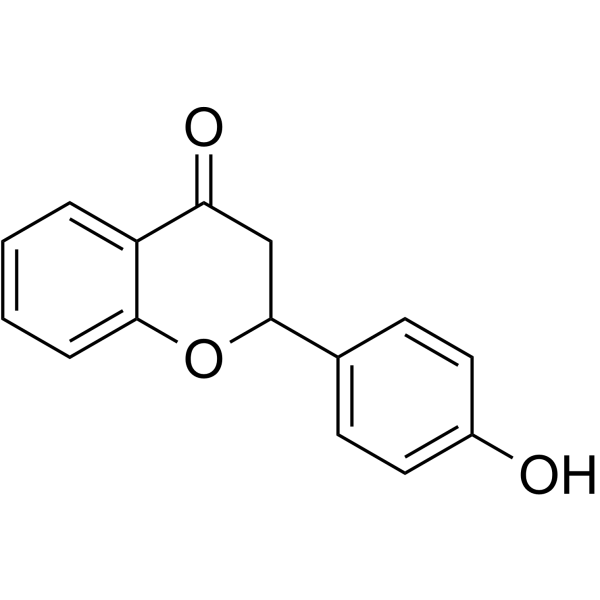
-
- HY-B2229
-
-
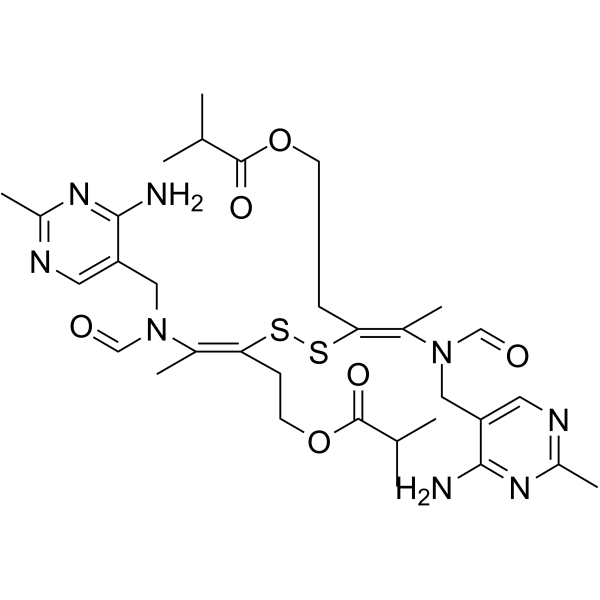
-
- HY-10001
-
-
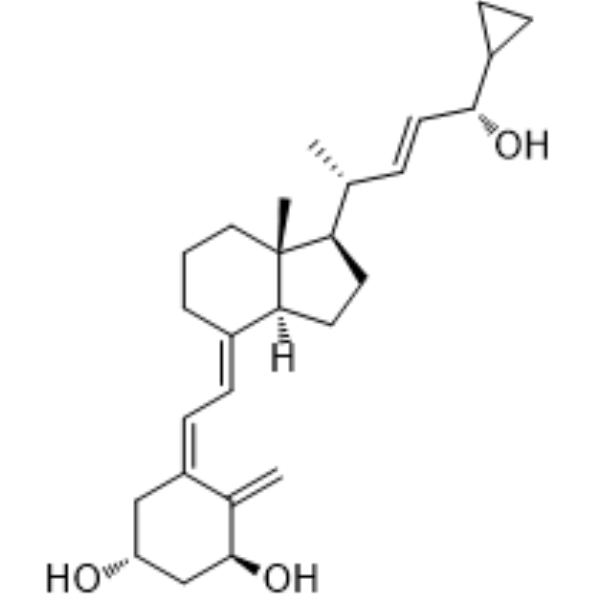
-
- HY-10001A
-
-
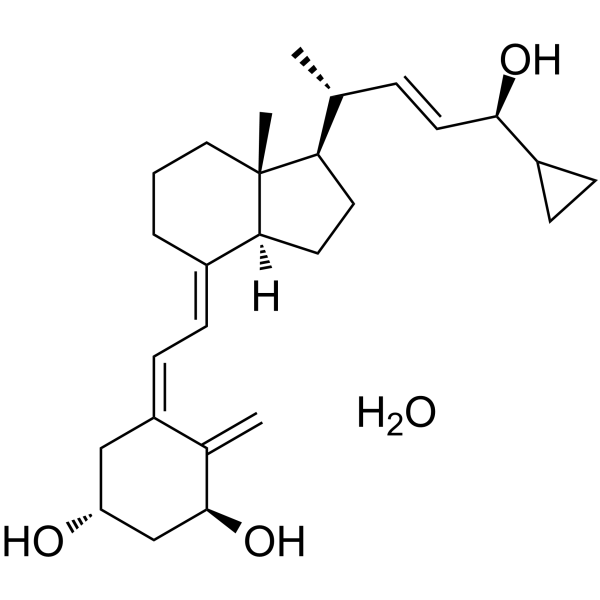
-
- HY-114671
-
|
CG-4203
|
Prostaglandin Receptor
|
Cardiovascular Disease
|
|
Taprostene (CG-4203) is a synthetic, chemically stable analogue of Prostacyclin (PGI2). Taprostene exhibits endothelium and myocardial protecting actions after acute myocardial ischemia and reperfusion in cats. Taprostene enhances cytoprotective actions, while minimizing unwanted hemodynamic effects .
|
-
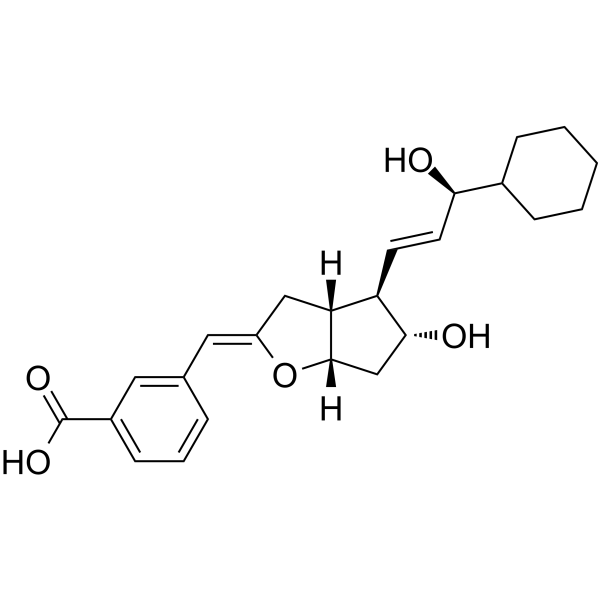
-
- HY-15640
-
Capsazepine
Maximum Cited Publications
29 Publications Verification
|
TRP Channel
Apoptosis
|
Cancer
|
|
Capsazepine is a synthetic analogue of the sensory neurone excitotoxin, and an antagonist of TRPV1 receptor with an IC50 of 562 nM.
|
-
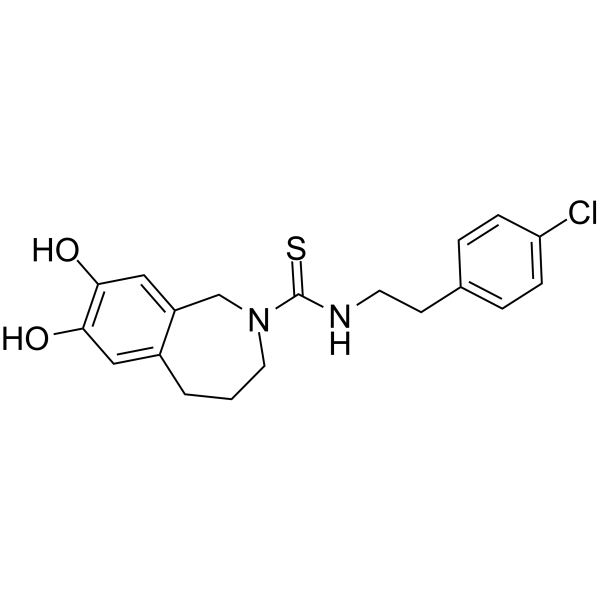
-
- HY-12309
-
|
AGN 190205; BASF-46928
|
Others
|
Neurological Disease
|
|
EC23 (AGN 190205) is a stable synthetic retinoid analogue and induces neuronal differentiation .
|
-
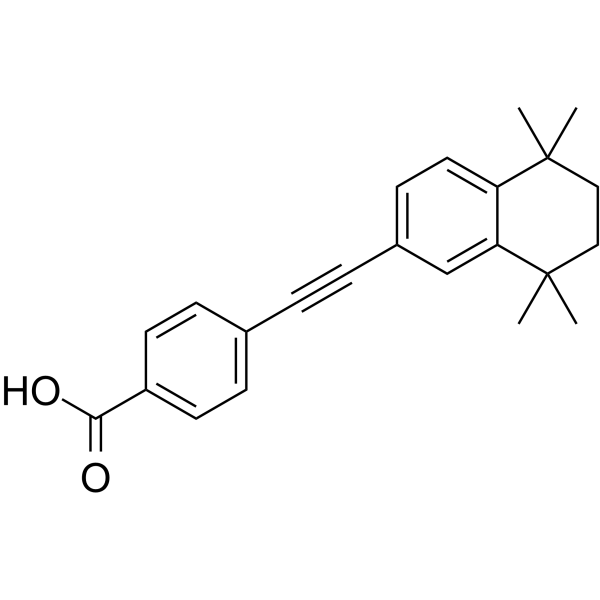
-
- HY-121241
-
|
|
Parasite
|
Infection
|
|
Dehydroemetine, a synthetic analogue of emetine dihydrochloride, is used for visceral leishmaniasis. Dehydroemetine used for anti-parasites .
|
-
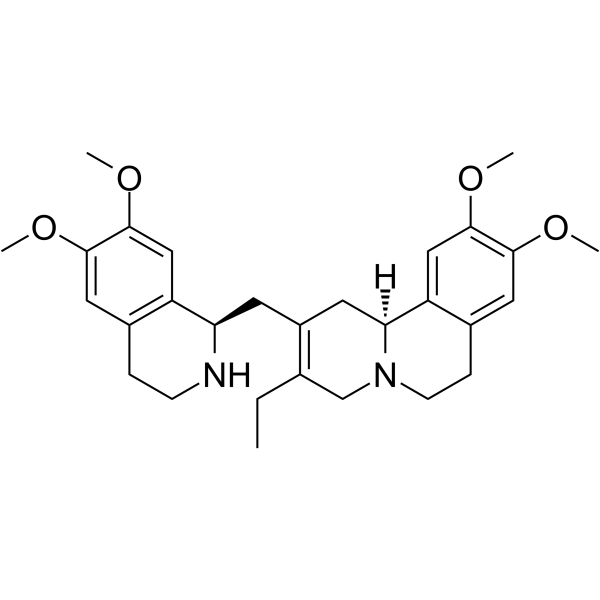
-
- HY-110337
-
|
|
Others
|
Others
|
|
FFN 102 mesylate is a synthetic biogenic neurotransmitter analogue with PH-dependent fluorescence and electrical activity .
|
-
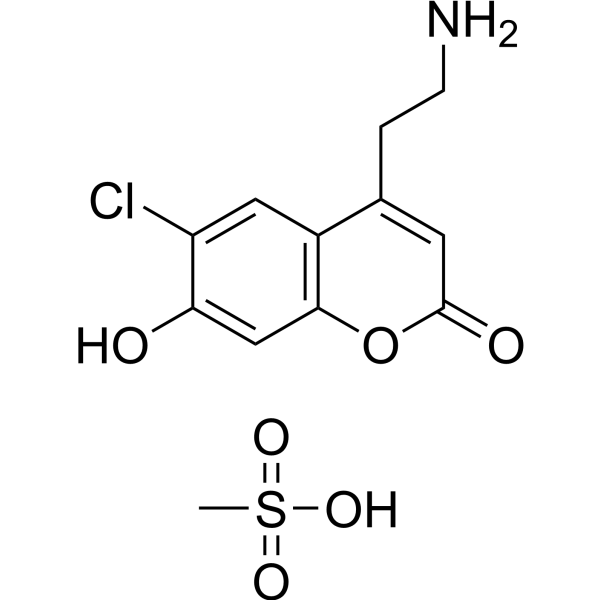
-
- HY-144003
-
-

-
- HY-12506A
-
|
1-Naphthylacetyl spermine trihydrochloride
|
iGluR
|
Neurological Disease
|
|
Naspm trihydrochloride (1-Naphthylacetyl spermine trihydrochloride), a synthetic analogue of Joro spider toxin, is a calcium permeable AMPA (CP-AMPA) receptors antagonist.
|
-
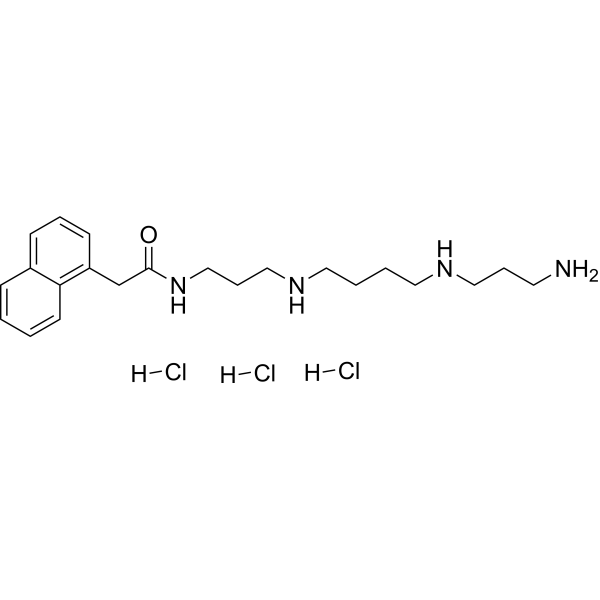
-
- HY-108415
-
|
ICI 80996 sodium salt
|
Prostaglandin Receptor
|
Endocrinology
|
|
Cloprostenol sodium salt (ICI 80996 sodium salt) is a potent synthetic prostaglandin analogue, acts as a luteolytic agent , and is a PGF2α receptor agonist .
|
-
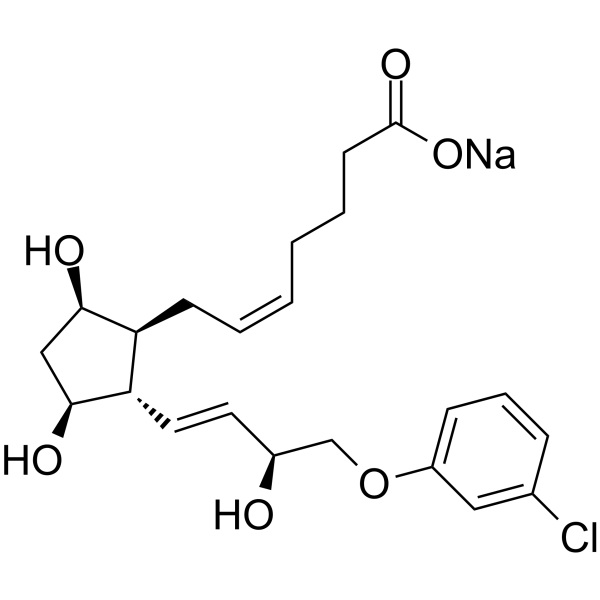
-
- HY-12506
-
|
1-Naphthylacetyl spermine
|
iGluR
|
Neurological Disease
|
|
Naspm (1-Naphthyl acetyl spermine), a synthetic analogue of Joro spider toxin, is a calcium permeable AMPA (CP-AMPA) receptors antagonist.
|
-

-
- HY-P0051
-
|
|
|
|
|
Lecirelin, a synthetic gonadotropin-releasing hormone (GnRH) analogue, acts as a GnRH agonist. Lecirelin is widely used for the research of bovine ovarian follicular cysts .
|
-
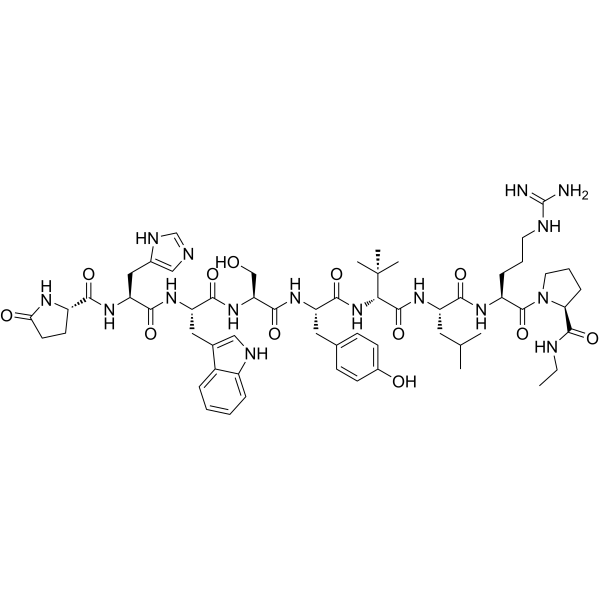
-
- HY-10001R
-
|
MC 903 (Standard); Calcipotriene (Standard)
|
VD/VDR
|
Inflammation/Immunology
Cancer
|
|
Calcipotriol (Standard) is the analytical standard of Calcipotriol. This product is intended for research and analytical applications. Calcipotriol is a synthetic VitD3 analogue with a high affinity for the vitamin D receptor.
|
-
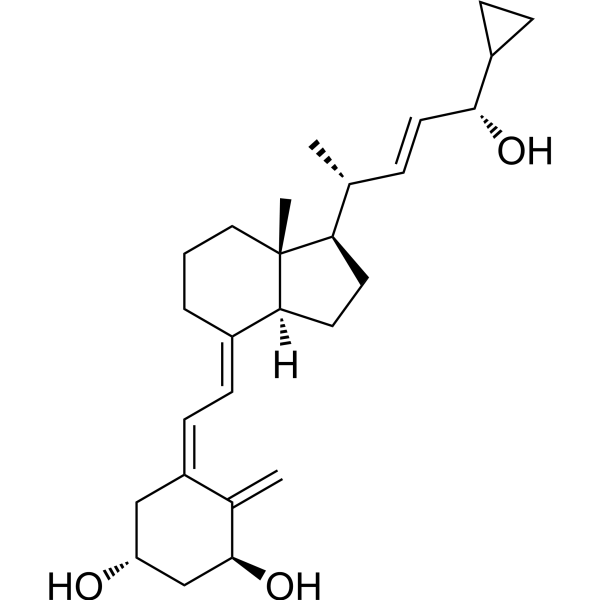
-
- HY-116117
-
|
|
Others
|
Others
|
|
Salicylcurcumin is a synthetic curcumin analogue with antioxidant activity. Salicylcurcumin may affect lipid peroxidation in fish, favoring increased survival, disease resistance, and ultimately growth rate .
|
-
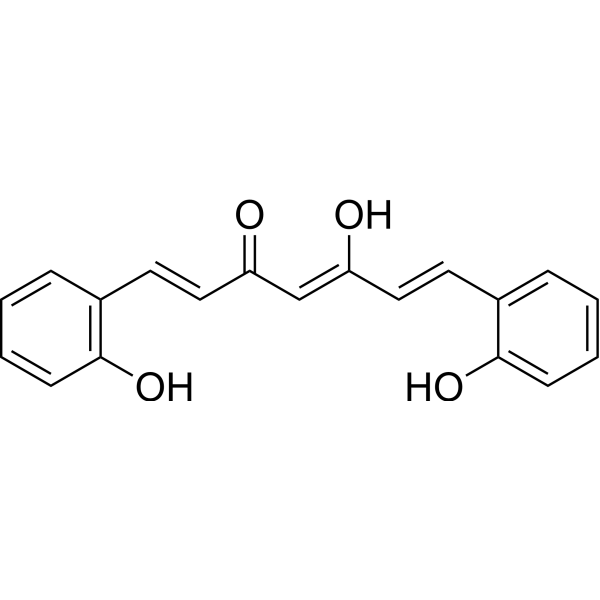
-
- HY-A0096S
-
-
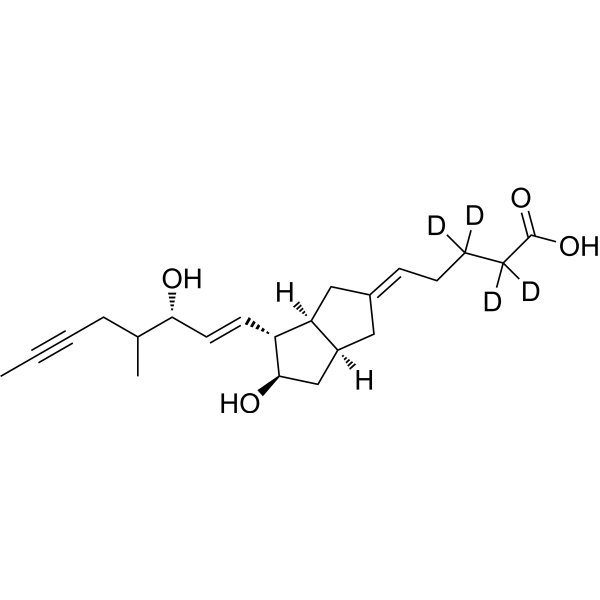
-
- HY-12522
-
|
Aur0101; Auristatin-0101
|
Microtubule/Tubulin
ADC Cytotoxin
|
Cancer
|
|
PF-06380101 (Aur0101), an auristatin microtubule inhibitor, is a cytotoxic Dolastatin 10 analogue. PF-06380101 (Aur0101) shows excellent potencies in tumor cell proliferation assays and differential ADME properties when compared to other synthetic auristatin analogues that are used in the preparation of ADCs.
|
-
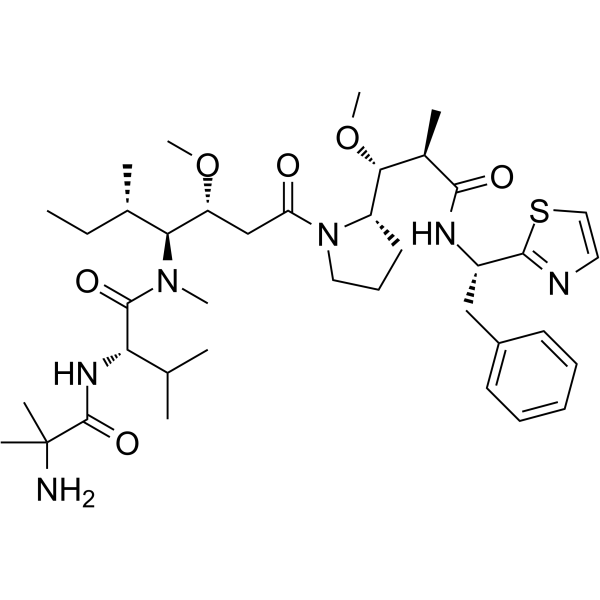
-
- HY-18678A
-
|
PT-141 Acetate
|
Melanocortin Receptor
|
Endocrinology
|
|
Bremelanotide Acetate (PT-141 Acetate), a synthetic peptide analogue of α-MSH, is an agonist at melanocortin receptors including the MC3R and MC4R for the treatment of sexual dysfunction .
|
-
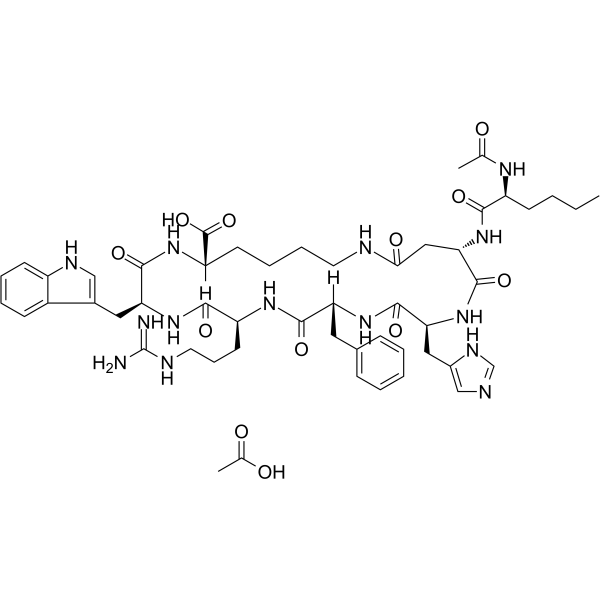
-
- HY-108415R
-
|
ICI 80996 sodium salt (Standard)
|
Prostaglandin Receptor
|
Endocrinology
|
|
Cloprostenol sodium salt (Standard) is the analytical standard of Cloprostenol sodium salt. This product is intended for research and analytical applications. Cloprostenol sodium salt (ICI 80996 sodium salt) is a potent synthetic prostaglandin analogue, acts as a luteolytic agent , and is a PGF2α receptor agonist .
|
-

-
- HY-A0195
-
|
|
|
|
|
Carboprost tromethamine is the synthetic 15-methyl analogue of prostaglandin F2α. Carboprost tromethamine can effectively promote law contraction of the uterus and significantly reduce the amount of bleeding during and after delivery .
|
-
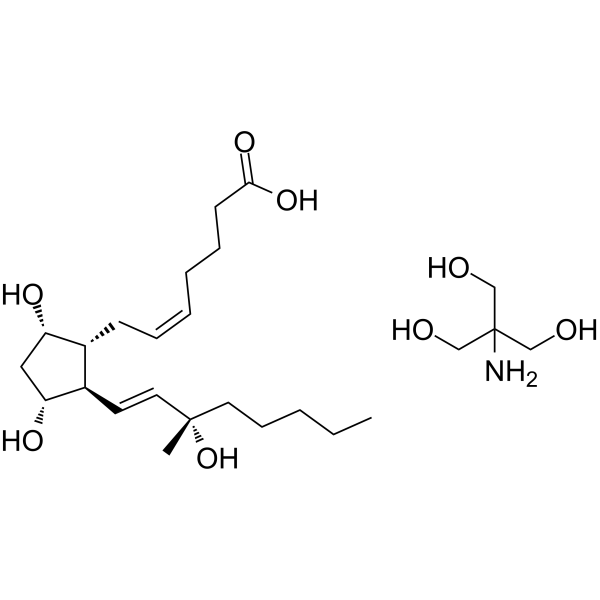
-
- HY-P1714
-
|
FE 203799
|
GLP Receptor
|
Metabolic Disease
|
|
Apraglutide (FE 203799), a synthetic 33-amino-acid peptide and a long-acting GLP-2 analogue, enhances adaptation and linear intestinal growth in a neonatal piglet model of short bowel syndrome with total resection of the ileum .
|
-

-
- HY-P1714A
-
|
FE 203799 TFA
|
GLP Receptor
|
Metabolic Disease
|
|
Apraglutide TFA (FE 203799 TFA), a synthetic 33-amino-acid peptide and a long-acting GLP-2 analogue, enhances adaptation and linear intestinal growth in a neonatal piglet model of short bowel syndrome with total resection of the ileum .
|
-

-
- HY-P3875
-
-
![[Arg-15,20,21,Leu17]-PACAP-Gly-Lys-Arg-NH2](//file.medchemexpress.com/product_pic/hy-p3875.gif)
-
- HY-15584
-
|
HTI-286; SPA-110
|
Microtubule/Tubulin
ADC Cytotoxin
Apoptosis
|
Cancer
|
|
Taltobulin (HTI-286), a synthetic analogue of the tripeptide hemiasterlin, is a potent antimicrotubule agent that circumvents P-glycoprotein-mediated resistance in vitro and in vivo. Taltobulin inhibits the polymerization of purified tubulin, disrupts microtubule organization in cells, and induces mitotic arrest, as well as apoptosis .
|
-
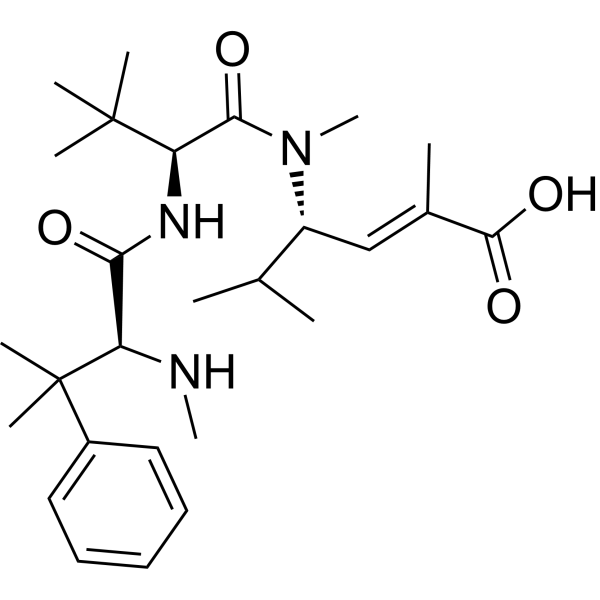
-
- HY-15584A
-
|
HTI-286 trifluoroacetate; SPA-110 trifluoroacetate
|
Microtubule/Tubulin
ADC Cytotoxin
Apoptosis
|
Cancer
|
|
Taltobulin trifluoroacetate (HTI-286 trifluoroacetate), a synthetic analogue of the tripeptide hemiasterlin, is a potent antimicrotubule agent that circumvents P-glycoprotein-mediated resistance in vitro and in vivo. Taltobulin trifluoroacetate inhibits the polymerization of purified tubulin, disrupts microtubule organization in cells, and induces mitotic arrest, as well as apoptosis .
|
-

-
- HY-15584B
-
|
HTI-286 hydrochloride; SPA-110 hydrochloride
|
Microtubule/Tubulin
ADC Cytotoxin
Apoptosis
|
Cancer
|
|
Taltobulin hydrochloride (HTI-286 hydrochloride), a synthetic analogue of the tripeptide hemiasterlin, is a potent antimicrotubule agent that circumvents P-glycoprotein-mediated resistance in vitro and in vivo. Taltobulin hydrochloride inhibits the polymerization of purified tubulin, disrupts microtubule organization in cells, and induces mitotic arrest, as well as apoptosis .
|
-
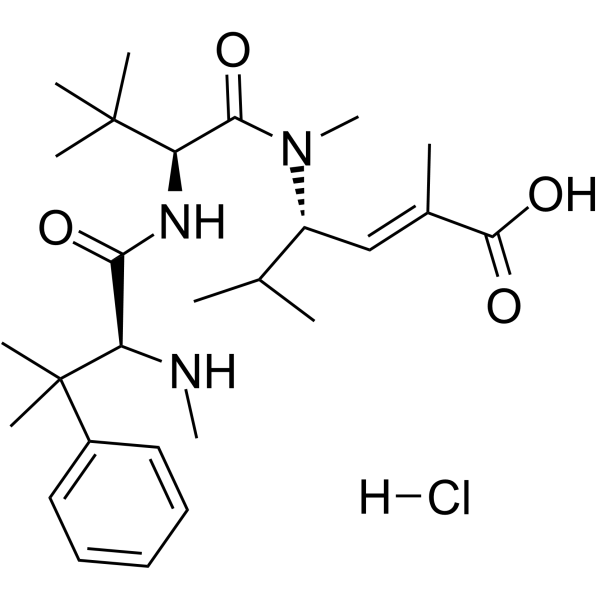
-
- HY-114570
-
|
NSC 286193; Riboxamide
|
Nucleoside Antimetabolite/Analog
Orthopoxvirus
|
Infection
Cancer
|
|
Tiazofurin (NSC 286193) is a synthetic nucleoside analogue with antineoplastic activity. Tiazofurin is anabolized intracellularly to tiazole-4-carboxamide adenine dinucleotide (TAD), a potent inhibitor of IMP dehydrogenase (IMPDH) . Tiazofurin also has anti-orthopoxvirus and anti-variola activities .
|
-
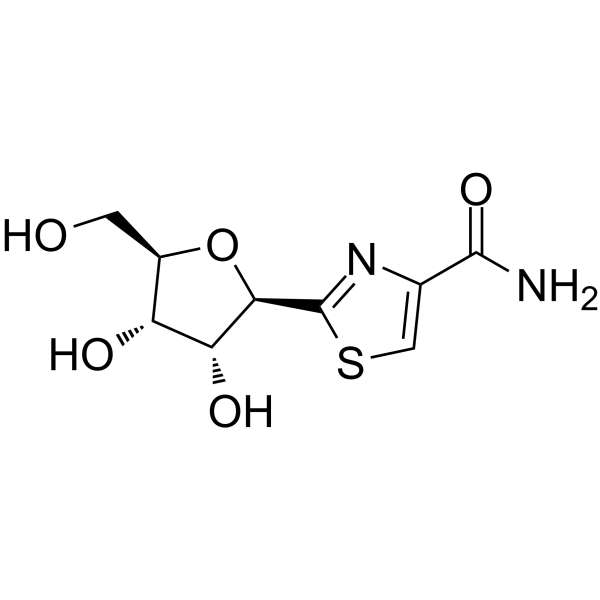
-
- HY-N8303
-
|
|
ERK
PAK
|
Neurological Disease
Inflammation/Immunology
|
|
Gardenin A is an orally active and synthetic PMF analogue with the neurotrophic effect for neurite outgrowth and neuronal differentiation. Gardenin A promotes neuritogenesis via activating MAPK/ERK, PKC, and PKA, but not TrkA, CREB signaling pathways. Gardenin A also has sedative, anxiolytic, antidepressant, and anticonvulsant effects .
|
-
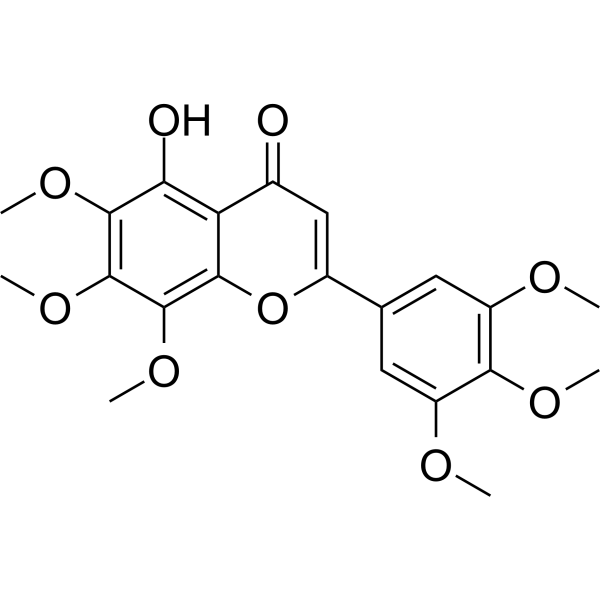
-
- HY-P3645
-
|
|
Melanocortin Receptor
|
Others
|
|
(Nle4)-α-MSH is a synthetic analogue of α-MSH (HY-P0252), a melanocyte-stimulating hormone. (Nle4)-α-MSH reversibly darkens frog skins and also exhibits prolonged activity after heat-alkali treatment .
|
-
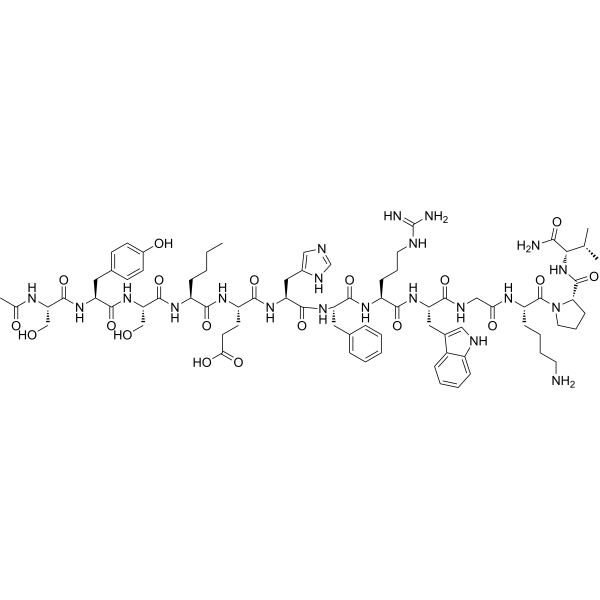
-
- HY-118189
-
|
|
Prostaglandin Receptor
|
Inflammation/Immunology
|
|
Misoprostol acid is an active metabolite of Misoprostol. Misoprostol is a synthetic analogue of prostaglandin E1 (PGE1), extensively absorbed, and undergoes rapid de-esterification to Misoprostol acid in the gastrointestinal tract after oral administration. Misoprostol can be used for non-steroidal anti-inflammatory drug-induced (NSAID) gastric ulcers . Misoprostol is an oral agent used to induce labor .
|
-
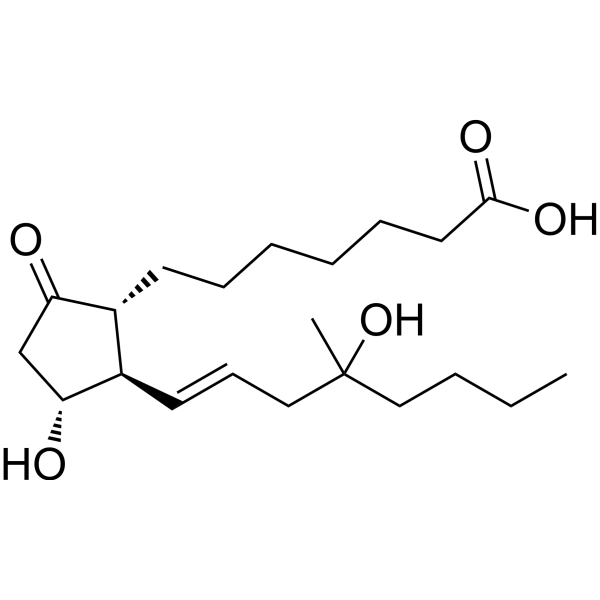
-
- HY-P0036
-
|
SMS 201-995
|
Somatostatin Receptor
Apoptosis
|
Cardiovascular Disease
Inflammation/Immunology
Endocrinology
Cancer
|
|
Octreotide (SMS 201-995) is a somatostatin receptor agonist and synthetic octapeptide endogenous somatostatin analogue. Octreotide (SMS 201-995) can bind to the somatostatin receptor and mainly subtypes 2, 3, and 5, increases Gi activity, and reduces intracellular cAMP production. Octreotide (SMS 201-995) has antitumor activity, mediates apoptosis and may also be used in disease studies in acromegaly .
|
-
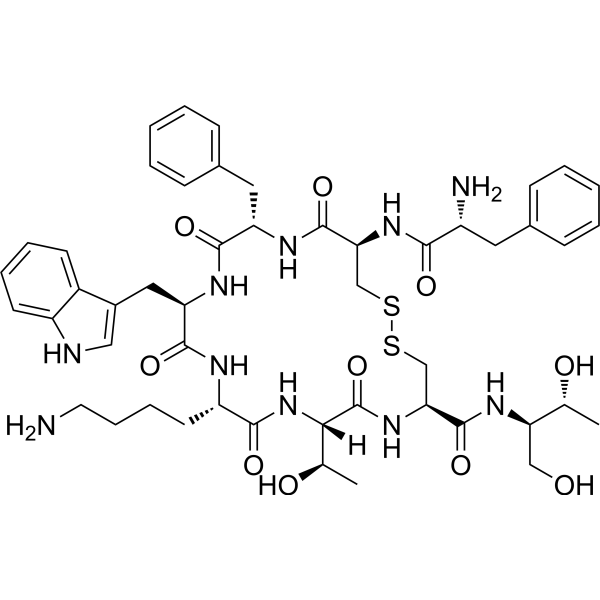
-
- HY-P0036B
-
|
SMS 201-995 pamoate
|
Somatostatin Receptor
Apoptosis
|
Cardiovascular Disease
Inflammation/Immunology
Endocrinology
Cancer
|
|
Octreotide (SMS 201-995) pamoate is a somatostatin receptor agonist and synthetic octapeptide endogenous somatostatin analogue. Octreotide pamoate can bind to the somatostatin receptors which are mainly subtypes 2, 3 and 5. Octreotide pamoate increases Gi activity and reduces intracellular cAMP production. Octreotide pamoate has antitumor activity, mediates apoptosis and may also be used in disease studies in acromegaly .
|
-
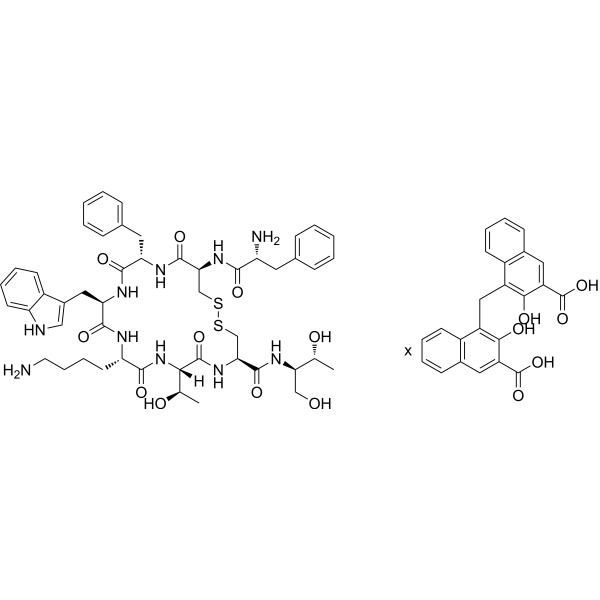
-
- HY-109520
-
|
|
Others
|
Inflammation/Immunology
|
|
Glatiramer acetate, a synthetic analogue of myelin basic protein and an immunomodulating agent, can be used for the research of multiple sclerosis. Glatiramer acetate exhibits strong and promiscuous binding to MHC molecules and consequent competition with various myelin antigens for their presentation to T cells. A further aspect of its action is potent induction of specific suppressor cells of the T helper 2 (Th2) type that migrate to the brain and lead to in situ bystander suppression .
|
-
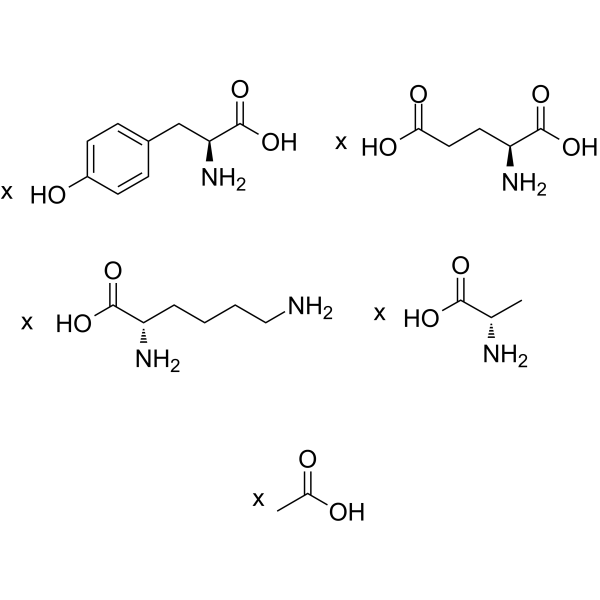
-
- HY-N2466A
-
|
MT-I acetate; [Nle4,D-Phe7]-α-MSH acetate
|
Melanocortin Receptor
|
Cancer
|
|
Melanotan I acetate is a potent non-selective melanocortin receptor (MCR) agonist. Melanotan I acetate is a synthetic analogue of α-melanocyte stimulating hormone (α-MSH) that stimulates melanogenesis. Melanotan I acetate can induce skin tanning by mimicking the actions of a-MSH on the melanocortin type 1 receptors (MC1R) of melanocytes. Melanotan I acetate can be used for sunlight-induced skin cancers research .
|
-
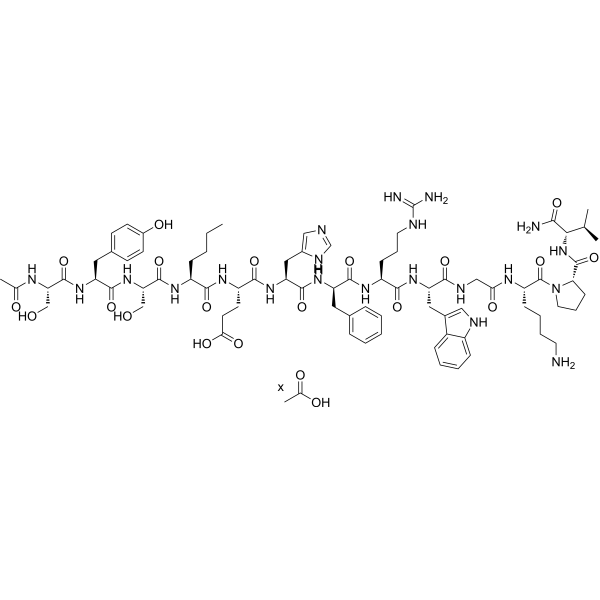
-
- HY-118189S
-
|
|
Isotope-Labeled Compounds
Prostaglandin Receptor
|
Inflammation/Immunology
|
|
Misoprostol acid-d5 is deuterium labeled Misoprostol acid. Misoprostol acid is an active metabolite of Misoprostol. Misoprostol is a synthetic analogue of prostaglandin E1 (PGE1), extensively absorbed, and undergoes rapid de-esterification to Misoprostol acid in the gastrointestinal tract after oral administration. Misoprostol can be used for non-steroidal anti-inflammatory drug-induced (NSAID) gastric ulcers[1]. Misoprostol is an oral agent used to induce labor[2].
|
-

-
- HY-144585
-
|
|
Microtubule/Tubulin
ADC Cytotoxin
|
Others
|
|
AGD-0182 is a microtubule disrupting agent. AGD-0182 is a synthetic analogue of the naturally occurring tubulin-binding molecule Dolastatin 10 . AGD-0182 is a click chemistry reagent, it contains an Azide group and can undergo copper-catalyzed azide-alkyne cycloaddition reaction (CuAAc) with molecules containing Alkyne groups. Strain-promoted alkyne-azide cycloaddition (SPAAC) can also occur with molecules containing DBCO or BCN groups.
|
-
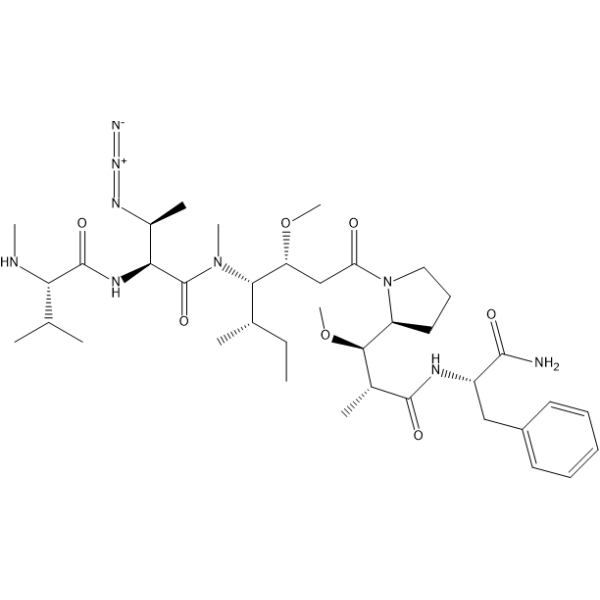
-
- HY-N2466
-
|
MT-I; [Nle4,D-Phe7]-α-MSH
|
Melanocortin Receptor
|
Neurological Disease
Cancer
|
|
Melanotan I is a potent non-selective melanocortin receptor (MCR) agonist. Melanotan I is a synthetic analogue of α-melanocyte stimulating hormone (α-MSH) that stimulates melanogenesis. Melanotan I can induce skin tanning by mimicking the actions of a-MSH on the melanocortin type 1 receptors (MC1R) of melanocytes. Melanotan I can be used for the research of sun-induced skin cancer, melanoma, inflammation and male erectile dysfunction .
|
-

-
- HY-12843
-
|
|
CDK
ERK
|
Cancer
|
|
Bohemine is a purine analogue and is a synthetic and selective CDK inhibitor with IC50s of 4.6 μM, 83 μM, and 2.7 μM for Cdk2/cyclin E, Cdk2/cyclin A, and Cdk9/cyclin T1, respectively. Bohemine also inhibits ERK2 with an IC50 of 52 μM and has less inhibitory effect on CDK1, CDK4 and CDK6. Bohemine has a broad spectrum anti-cancer activities .
|
-
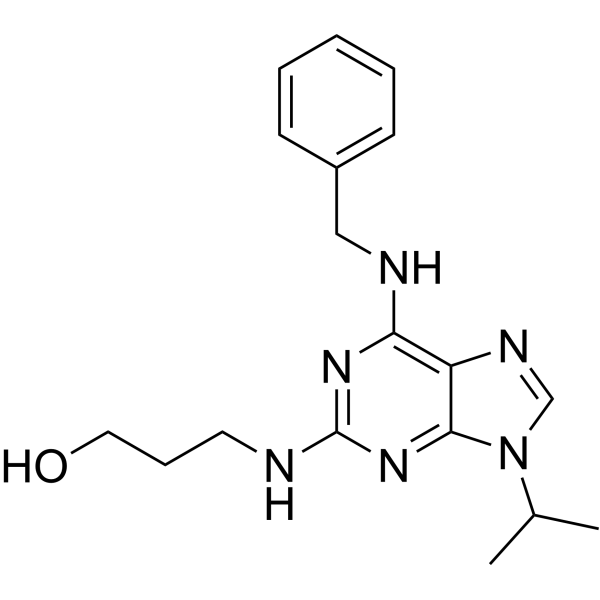
-
-
HY-L044
-
|
|
491 compounds
|
|
Nucleoside and nucleotide analogues are synthetic, chemically modified compounds that have been developed to mimic their physiological counterparts in order to exploit cellular metabolism and subsequently be incorporated into DNA and RNA to inhibit cellular division and viral replication. In addition to their incorporation into nucleic acids, nucleoside and nucleotide analogues can interact with and inhibit essential enzymes such as human and viral polymerases (that is, DNA-dependent DNA polymerases, RNA-dependent DNA polymerases or RNA-dependent RNA polymerases), kinases, ribonucleotide reductase, DNA methyltransferases, purine and pyrimidine nucleoside phosphorylase and thymidylate synthase. These actions of nucleoside and nucleotide analogues have potential therapeutic benefits — for example, in the inhibition of cancer cell growth, the inhibition of viral replication as well as other indications.
MCE offers a unique collection of 491 nucleotide compounds including nucleotide, nucleoside and their structural analogues. MCE Nucleotide Compound Library is a useful tool to discover anti-cancer and antiviral drugs for high throughput screening (HTS) and high content screening (HCS).
|
-
-
HY-L0120V
-
|
|
170,269 compounds
|
|
“BioDesign” approach incorporates key structural features of known pharmacologically relevant natural products (e.g. alkaloids and other secondary metabolites) into synthetically feasible medicinal chemistry scaffolds. In order to identify the privileged pharmacophores, ring systems and linkers, we have carried out statistical analysis of structural features of natural products, marketed drugs, and drug candidates.
Saturated, fused ring, spiro, and bridged systems with a tendency towards multiple chiral centers are highly privileged among natural products and marketed drugs yet these structures are very poorly represented in commercial libraries. This library addressed this market need by incorporating these privileged elements into the design of novel synthetic molecules with high molecular framework diversity, multiple stereogenic centers (≥2), and degree of saturation (Fsp3 > 0.5).
|
| Cat. No. |
Product Name |
Type |
-
- HY-144003
-
|
|
Drug Delivery
|
|
BAY-R 1005, an immunoenhancing agent, is a synthetic glycolipid analogue (GLA), which is supposed to modulate antibody synthesis .
|
| Cat. No. |
Product Name |
Target |
Research Area |
-
- HY-16757
-
|
NNZ-2566
|
Peptides
|
Neurological Disease
|
|
Trofinetide (NNZ-2566), a synthetic analogue of the endogenous N-terminus tripeptide, Glycine-Proline-Glutamate (GPE), has been shown to be neuroprotective in animal models of brain injury.
|
-
- HY-18678A
-
|
PT-141 Acetate
|
Melanocortin Receptor
|
Endocrinology
|
|
Bremelanotide Acetate (PT-141 Acetate), a synthetic peptide analogue of α-MSH, is an agonist at melanocortin receptors including the MC3R and MC4R for the treatment of sexual dysfunction .
|
-
- HY-P1714
-
|
FE 203799
|
GLP Receptor
|
Metabolic Disease
|
|
Apraglutide (FE 203799), a synthetic 33-amino-acid peptide and a long-acting GLP-2 analogue, enhances adaptation and linear intestinal growth in a neonatal piglet model of short bowel syndrome with total resection of the ileum .
|
-
- HY-P4957
-
|
|
Peptides
|
Others
|
|
Octreotide dimer parallel is a dimer parallel of Octreotide. Octreotide (HY-P0036) is a somatostatin receptor agonist and synthetic octapeptide endogenous somatostatin analogue .
|
-
- HY-P4011
-
|
|
Peptides
|
Neurological Disease
|
|
[1,6-Aminosuberic acid]-arginine-Vasotocin is a synthetic peptide analogue to neurohypophyseaI hormones. [1,6-Aminosuberic acid]-arginine-Vasotocin has excitatory effect on the periodically oxcillating neuron (PON) of A. fulica .
|
-
- HY-P1714A
-
|
FE 203799 TFA
|
GLP Receptor
|
Metabolic Disease
|
|
Apraglutide TFA (FE 203799 TFA), a synthetic 33-amino-acid peptide and a long-acting GLP-2 analogue, enhances adaptation and linear intestinal growth in a neonatal piglet model of short bowel syndrome with total resection of the ileum .
|
-
- HY-P3875
-
-
- HY-P3645
-
|
|
Melanocortin Receptor
|
Others
|
|
(Nle4)-α-MSH is a synthetic analogue of α-MSH (HY-P0252), a melanocyte-stimulating hormone. (Nle4)-α-MSH reversibly darkens frog skins and also exhibits prolonged activity after heat-alkali treatment .
|
-
- HY-P3952
-
|
|
Peptides
|
Metabolic Disease
|
|
(D-Trp8,D-Cys14)-Somatostatin-14 is a Somatostatin synthetic analogue. (D-Trp8,D-Cys14)-Somatostatin-14 can be used for the research of metabolic related diseases .
|
-
- HY-P0036
-
Octreotide
Maximum Cited Publications
8 Publications Verification
SMS 201-995
|
Somatostatin Receptor
Apoptosis
|
Cardiovascular Disease
Inflammation/Immunology
Endocrinology
Cancer
|
|
Octreotide (SMS 201-995) is a somatostatin receptor agonist and synthetic octapeptide endogenous somatostatin analogue. Octreotide (SMS 201-995) can bind to the somatostatin receptor and mainly subtypes 2, 3, and 5, increases Gi activity, and reduces intracellular cAMP production. Octreotide (SMS 201-995) has antitumor activity, mediates apoptosis and may also be used in disease studies in acromegaly .
|
-
- HY-P0036B
-
|
SMS 201-995 pamoate
|
Somatostatin Receptor
Apoptosis
|
Cardiovascular Disease
Inflammation/Immunology
Endocrinology
Cancer
|
|
Octreotide (SMS 201-995) pamoate is a somatostatin receptor agonist and synthetic octapeptide endogenous somatostatin analogue. Octreotide pamoate can bind to the somatostatin receptors which are mainly subtypes 2, 3 and 5. Octreotide pamoate increases Gi activity and reduces intracellular cAMP production. Octreotide pamoate has antitumor activity, mediates apoptosis and may also be used in disease studies in acromegaly .
|
-
- HY-148195
-
|
|
Peptides
|
Neurological Disease
|
|
NNZ 2591 is a synthetic analogue of a small peptide of cyclic glycine proline (cGP). NNZ 2591 shows orally active and cross the blood-brain barrier. NNZ 2591 shows neuroprotective after ischemic brain injury. NNZ 2591 improves motor function in a rat model of Parkinson's disease. NNZ 2591 has the potential for the research of ischemic brain injury and angelman syndrome .
|
-
- HY-N2466A
-
|
MT-I acetate; [Nle4,D-Phe7]-α-MSH acetate
|
Melanocortin Receptor
|
Cancer
|
|
Melanotan I acetate is a potent non-selective melanocortin receptor (MCR) agonist. Melanotan I acetate is a synthetic analogue of α-melanocyte stimulating hormone (α-MSH) that stimulates melanogenesis. Melanotan I acetate can induce skin tanning by mimicking the actions of a-MSH on the melanocortin type 1 receptors (MC1R) of melanocytes. Melanotan I acetate can be used for sunlight-induced skin cancers research .
|
-
- HY-N2466
-
|
MT-I; [Nle4,D-Phe7]-α-MSH
|
Melanocortin Receptor
|
Neurological Disease
Cancer
|
|
Melanotan I is a potent non-selective melanocortin receptor (MCR) agonist. Melanotan I is a synthetic analogue of α-melanocyte stimulating hormone (α-MSH) that stimulates melanogenesis. Melanotan I can induce skin tanning by mimicking the actions of a-MSH on the melanocortin type 1 receptors (MC1R) of melanocytes. Melanotan I can be used for the research of sun-induced skin cancer, melanoma, inflammation and male erectile dysfunction .
|
| Cat. No. |
Product Name |
Category |
Target |
Chemical Structure |
| Cat. No. |
Product Name |
Chemical Structure |
-
- HY-A0096S
-
|
|
|
Iloprost-d4 (Ciloprost-d4) is the deuterium labeled Iloprost. Iloprost (ZK 36374) is a synthetic analogue of prostacyclin PGI2[1][2].
|
-

-
- HY-118189S
-
|
|
|
Misoprostol acid-d5 is deuterium labeled Misoprostol acid. Misoprostol acid is an active metabolite of Misoprostol. Misoprostol is a synthetic analogue of prostaglandin E1 (PGE1), extensively absorbed, and undergoes rapid de-esterification to Misoprostol acid in the gastrointestinal tract after oral administration. Misoprostol can be used for non-steroidal anti-inflammatory drug-induced (NSAID) gastric ulcers[1]. Misoprostol is an oral agent used to induce labor[2].
|
-

| Cat. No. |
Product Name |
|
Classification |
-
- HY-16247
-
|
HE3235
|
|
Alkynes
|
|
Apoptone, synthetic analogue of 3β-androstanediol, is an orally bioavailable anticancer agent. Apoptone is active in rodent models of prostate and breast cancer . Apoptone is a click chemistry reagent, it contains an Alkyne group and can undergo copper-catalyzed azide-alkyne cycloaddition (CuAAc) with molecules containing Azide groups.
|
-
- HY-144585
-
|
|
|
Azide
|
|
AGD-0182 is a microtubule disrupting agent. AGD-0182 is a synthetic analogue of the naturally occurring tubulin-binding molecule Dolastatin 10 . AGD-0182 is a click chemistry reagent, it contains an Azide group and can undergo copper-catalyzed azide-alkyne cycloaddition reaction (CuAAc) with molecules containing Alkyne groups. Strain-promoted alkyne-azide cycloaddition (SPAAC) can also occur with molecules containing DBCO or BCN groups.
|
Your information is safe with us. * Required Fields.
Inquiry Information
- Product Name:
- Cat. No.:
- Quantity:
- MCE Japan Authorized Agent:





























![[Arg-15,20,21,Leu17]-PACAP-Gly-Lys-Arg-NH2](http://file.medchemexpress.com/product_pic/hy-p3875.gif)

















